 Credit: Mark Hachman / IDG
Credit: Mark Hachman / IDG
Acer’s Swift 3 (2019) should attract the type of savvy notebook PC buyer searching for a little more graphics oomph than the standard integrated GPU provides. Combining an 8th-gen “Whiskey Lake” chip plus a discrete Nvidia GeForce MX150 GPU opens up more opportunities for light gaming without breaking the bank.
Acer’s new Swift 3 clamshell is a generally solid midrange notebook, though it suffers in two key areas. First, the integrated audio isn’t much to write home about, even with headphones. We found the fingerprint reader lacking as well. But Acer’s Swift 3 also boasts excellent performance and a solid ten hours or so of battery life, with a comfortable keyboard and pleasing IPS display, too.
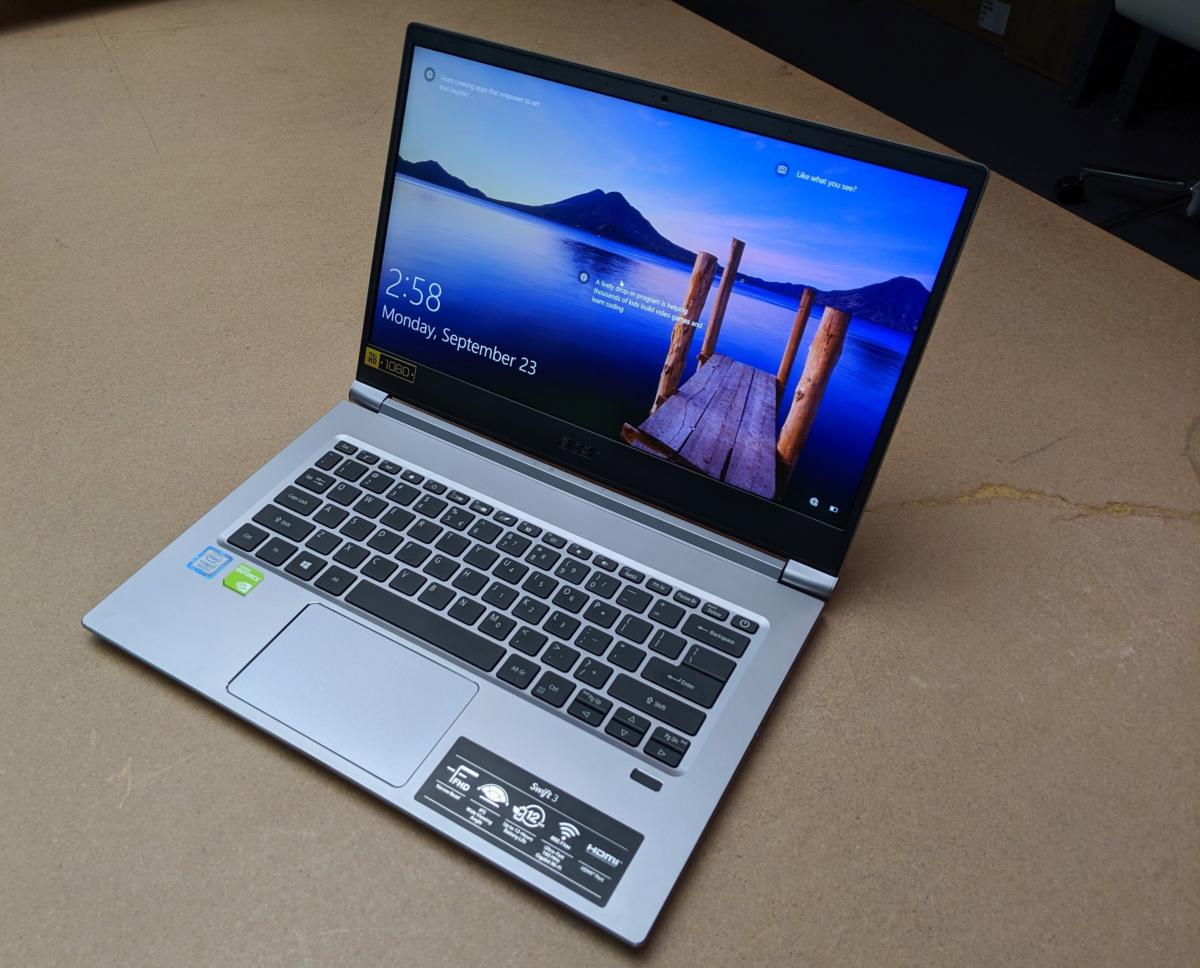 Mark Hachman / IDG
Mark Hachman / IDG
Acer’s Swift 3.
Acer Swift 3 (2019) (SF314-55G-78U1) basic specs:
- Display: 14-inch IPS (1920x1080) non-touch
- Processor: Intel 1.5GHz Core i7-8565U (“Whiskey Lake”)
- Graphics: Intel UHD 620, Nvidia GeForce MX150 @937MHz
- Memory: 8GB DDR4
- Storage: 256PCIe SSD
- Ports: 1 USB-C 3.1 Gen 2 (DisplayPort, USB charging) , 2 USB 3.0 Type A (one with power-off charging), 1 HDMI, SD card, 3.5mm jack, Kensington lock
- Camera: 720p (1280 x 720) with SHDR
- Battery: 50.7Wh (design); 49.8Wh (tested)
- Wireless: Gigabit Wi-Fi 2x2 802.11ac 160MHz; Bluetooth 5.0
- Additional features: Fingerprint sensor
- Operating system: Windows 10 Home
- Dimensions: 8.98 x 12.72 x 0.59 in (15mm)
- Weight: 3.05 pounds, 3.7 pounds with charger
- Color: Aluminum
-
Price: MSRP: $999; Amazon: $899.11
Don’t think of Acer’s Swift 3 as a cheaper version of the Acer Swift 7, which is basically the epitome of thin-and-light PCs. Instead, the Swift 3 is a less expensive, general-purpose PC that’s somewhat thicker and heavier than the Swift 7. That allows for a more full-featured selection of ports: both USB-A and USB-C, plus HDMI, among others. We think you’d prefer 512GB of storage as opposed to the 256GB on the Swift 3, but that’s an acceptable tradeoff to keep the price low.
The Swift 3’s aluminum chassis is sturdily built, with no discernible flex either in the keyboard or the chassis itself. The clamshell notebook folds back flat. At 3 pounds, it shouldn’t weigh too heavily in your bag.
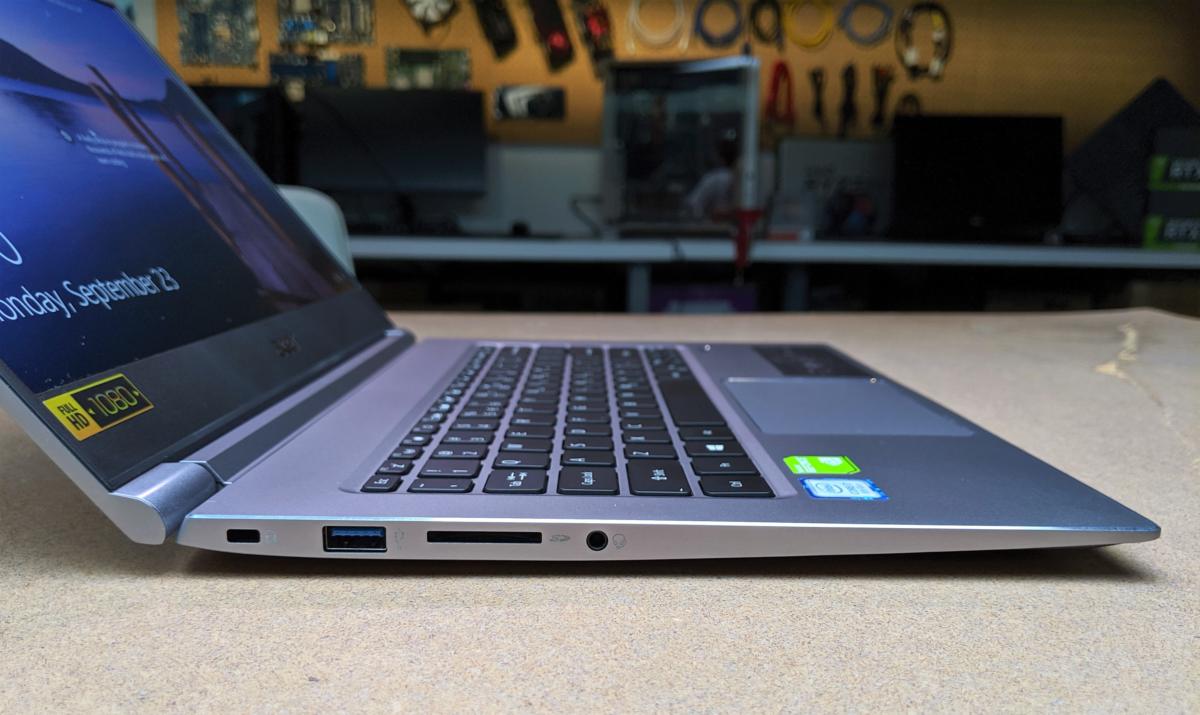 Mark Hachman / IDG
Mark Hachman / IDG
On the left side of the Acer Swift 3 chassis is an a Kensington lock, a USB-A port, an SD card slot, and a headphone jack.
The fan does have a tendency to kick on quickly under load, though that’s usually something beyond just typing in a document or even loading a webpage. When the fan does come on, it's pretty quiet, helped by spacious venting underneath and at the back of the laptop. There was no discernible coil whine in our review unit.
Though it’s not immediately obvious where the Acer saved money in designing the Swift 3, the display offers some clues. For one, the 1080p IPS display isn’t touch-enabled, meaning you won’t be able to navigate with a finger or stylus. Also, the Swift 3's maximum 280 nits of luminosity (measured at the center of the screen) is just above the 250 nits we consider appropriate for daily use. In general, though, IPS displays are pleasant to work upon, and the Swift 3's is no exception.
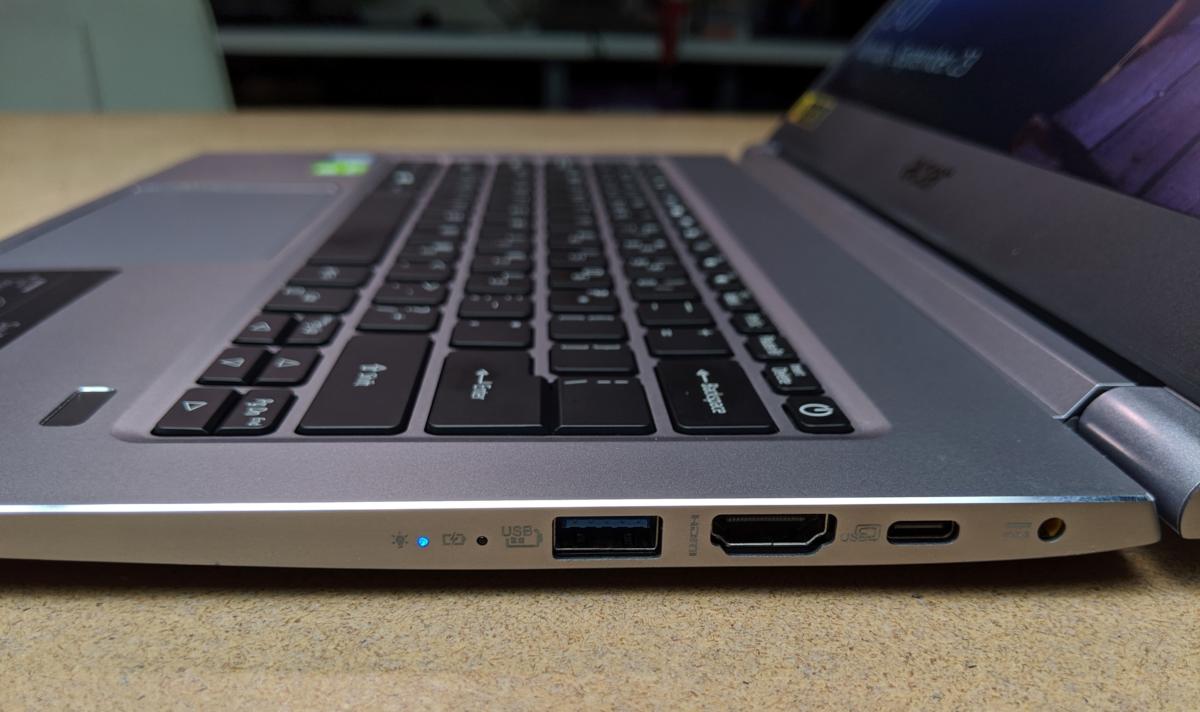 Mark Hachman / IDG
Mark Hachman / IDG
On the left side of the Acer Swift 3 chassis is another USB-A port, an HDMI port, a USB-C port, and the power jack. Convenient labeling helps identify what each port can be used for.
Acer includes a fairly standard complement of expansion ports. There's one USB-C, though it doesn’t include any Thunderbolt capabilities. It’s also a bit disappointing to see generic USB 3.0 Type-A ports, rather than the faster USB 3.1. Copying files to and from an external hard drive may take a bit longer than other drives over the slower ports, though you’ll probably just accept it without thinking. There’s also a full-sized SD card slot, which is becoming less common in laptops, but will be a godsend for those still using the cards for photo or video storage.
Listening to music or other audio played back on laptop speakers is usually an adequate rather than transcendent experience. Acer’s Swift 3 is slightly disappointing: The speakers deliver plenty of volume, but with a flat low end and somewhat weak midrange.
 Mark Hachman / IDG
Mark Hachman / IDG
The Swift 3’s downward-facing speakers are surrounded by a number of user-accessible screws.
Unfortunately, Realtek’s audio app doesn’t include any adjustable settings, such as a graphics equalizer. Even headphones didn’t quite deliver the fuller range of sound I was hoping for. If you’re somewhat forgiving, though, the Swift 3’s speakers pass the competency test.
Typing on the Acer Swift 3 is an unexpected pleasure. In my experience, the individual keys seem to be somewhat smaller than the competition's, even though there seems to be plenty of extra space on either side of the tray. Still, there’s a pleasant resiliency to the keyboard as a whole. It's also backlit (without gradation—it’s either on or off), though it turns off automatically after 10 seconds or so. The trackpad is good—rather large, and it recognized my clicks nearly all the way to the top of the sensor.
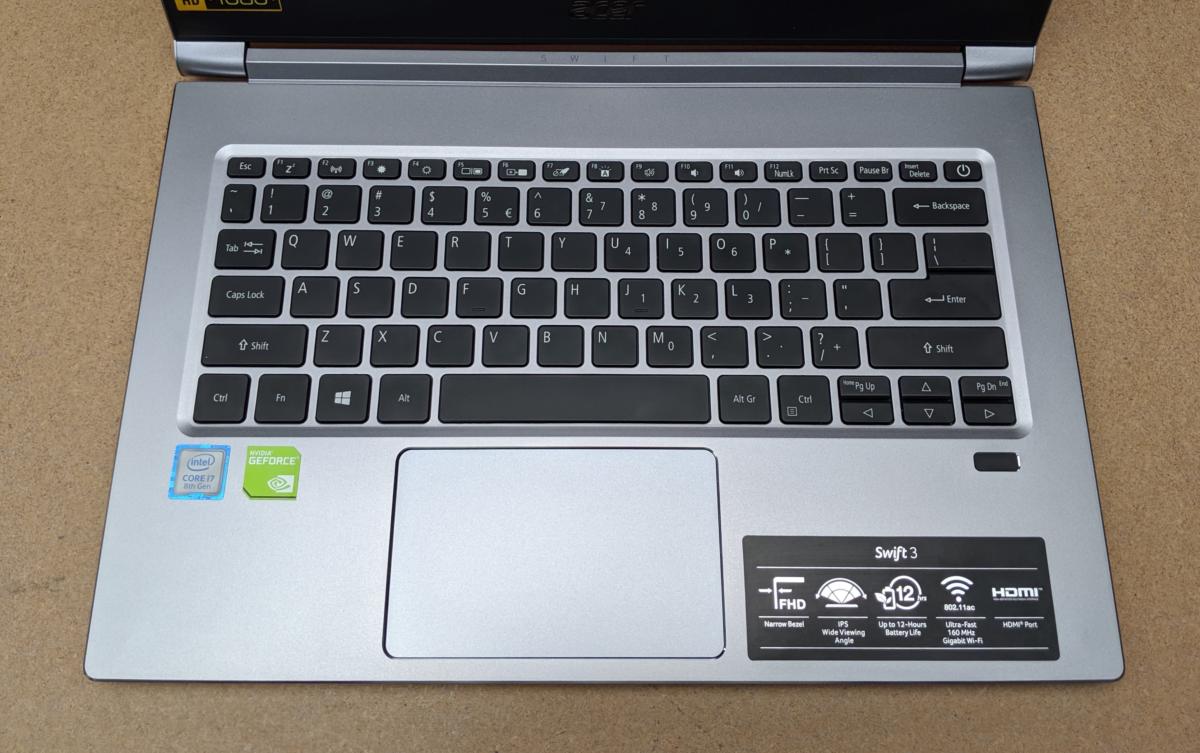 Mark Hachman / IDG
Mark Hachman / IDG
The Swift 3’s keyboard layout.
The Swift 3’s keyboard layout is pretty standard, with the normal array of function keys and the typical cross-shaped arrow navigation in the lower right-hand corner. The keyboard sports one key with a dollar sign and another with a Euro currency symbol, though the latter didn’t seem to work using the standard Windows shortcuts. There are keys to disable the trackpad, adjust the brightness, and place the laptop into a sleep state. If you’re concerned about hackers looking at you without permission, you’’ll need to use the time-honored kluge of placing a piece of tape over the user-facing webcam or turning it off within the Windows Settings menu; there's no privacy switch.
To the right and below the keyboard is the fingerprint sensor, which doesn’t hold a candle to the types of sensor mounted under the power buttons in Huawei’s Matebook line or Lenovo’s ThinkBook. Although the sensor detected my finger, it couldn’t do it consistently enough to establish even a baseline fingerprint for comparison.
 Mark Hachman / IDG
Mark Hachman / IDG
One of the Swift 3’s disappointing features is its fingerprint sensor, which had trouble gathering enough samples for a reference image.
Together, Acer and Microsoft bundle a significant number of potentially unwanted apps on the Acer Swift 7, with one exception: a piece of utility software that can be used as an overall control for the laptop experience. Many laptop makers, including Samsung and Lenovo, includes such a utility, which can be used for updating the laptop’s BIOS, adjusting some of the key functionality, and adjusting backlighting, among others. Acer’s contribution is the Acer Care Center utility, though it’s labeled just as “Care Center” in the Start menu. It’s a one-stop shop for information about the PC.
Separately, Acer provides Quick Access. About the only exclusive feature this app provides is the ability to manage power-off USB charging, such as the ability to turn off the feature when the laptop’s battery hits 30 percent.
Acer also includes online registration and the Acer Collection S, a hand-picked collection of free and paid apps that can be downloaded. There are also free trials of the PhotoDirector photo editing tool, the PowerDirector video editing package, plus a trial subscription to Norton Security. One interesting piece of bundleware was Mozilla’s Firefox browser; you usually doesn’t see third-party browsers being added to notebook PCs.
Acer Swift 3 performance: Near the top
There’s one gotcha that you should be aware of with the Acer Swift 3. Though you should be pleased that it includes a discrete Nvidia GeForce MX150 GPU, Acer also cut a corner here.
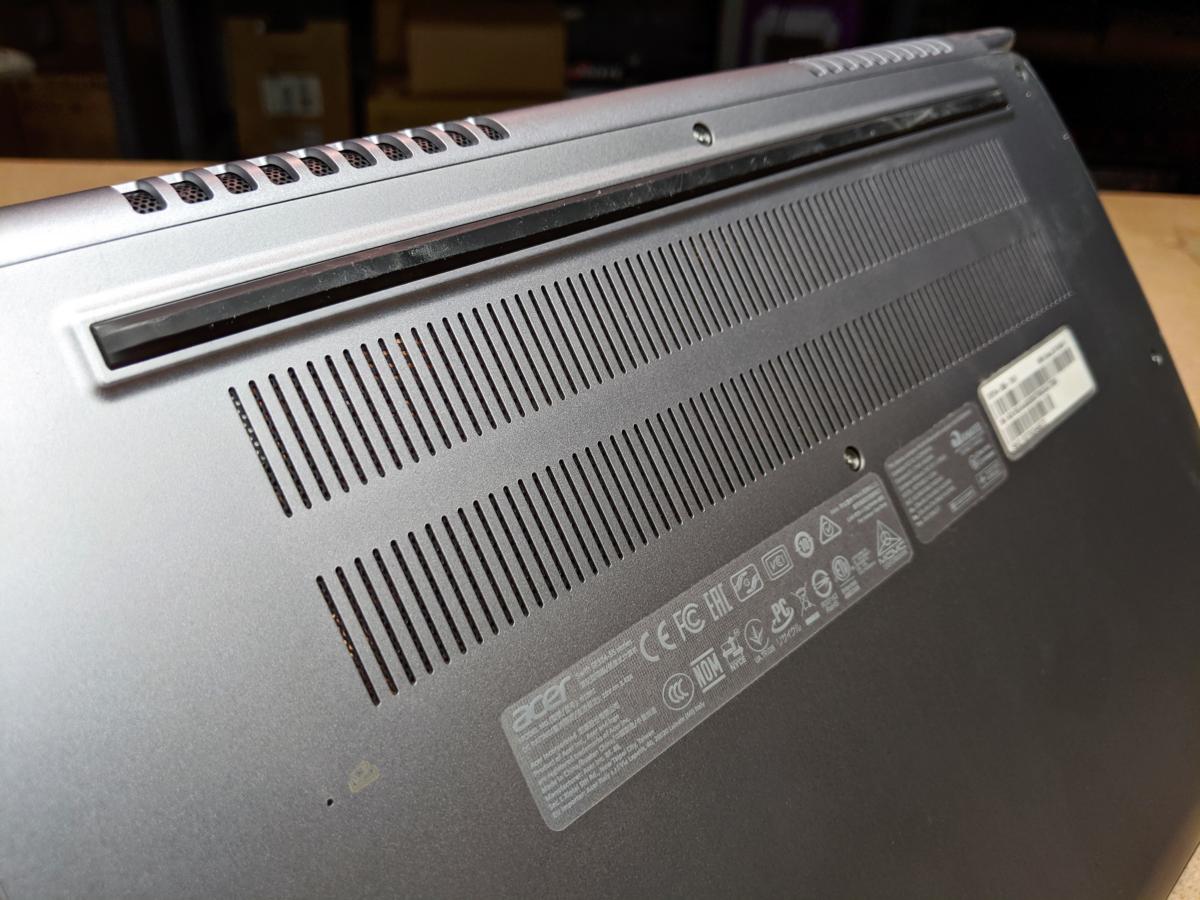 Mark Hachman / IDG
Mark Hachman / IDG
Excellent venting keeps the Swift 3 running at peak performance.
That’s because the GeForce MX150 ships in two versions: the standard, 1,469MHz version, and a downclocked 937MHz variant. (We ran into this with the Huawei Matebook 13, which used the faster version of the MX150, and the Matebook X Pro, which used the slower variant. Read our Matebook 13 review if you want to see what effect the two different clock speeds have on performance.) Though the Swift 3 makes no claims to being a “pro”-level product, it, too, uses the slower MX150, somewhat diminishing the value of a discrete GPU.
Otherwise, there’s not that much to complain about here. You’re still seeing some benefit from the discrete GPU, and Intel’s Whiskey Lake chip delivers solid performance. We’ve compared the Swift 3 against a number of other similar general-purpose machines, including a few with the MX150. Note that we’re comparing the Swift 3 against the HP Spectre x360 15t, which powers an OLED display with a comparable MX150 chip. Not shown is the HP Spectre x360 15, which uses a more powerful GeForce GTX 1050 Ti—almost triple the graphics performance, but at more than double the price.
We test with a mixture of real-world and synthetic benchmarks, testing the CPU, GPU, and battery life. PCMark leads, with two versions: PCMark 8, which separates its tests into Work, Home, and Creative tests; and PCMark 10, a more modern benchmark which lumps them all together into a single number. We use the more prosaic Work test (office spreadsheets, VoIP calls, and web browsing) with the Creative test (gaming, photo editing, video editing) to evaluate the tablet for work and play. The Acer Swift compares very well—near the top—in both cases.
 Mark Hachman / IDG
Mark Hachman / IDG
Acer’s Swift 3 rises to the top of the heap, helped by its Core i7 “Whiskey Lake” processor.
 Mark Hachman / IDG
Mark Hachman / IDG
Again, a powerful processor and GPU help elevate the Acer Swift 3 (2019).
We don’t have as many PCMark 10 tests under our belt, but here’s a comparison against a small subset of its competition.
 Mark Hachman / IDG
Mark Hachman / IDG
In the more modern PCMark 10 benchmark, Acer’s Swift 3 again does well.
Maxon’s Cinebench test is a widely used synthetic benchmark that pushes the limits of the CPU, in both single-core and multi-core mode. The test renders a computer-generated scene using either the older R15 benchmark, or the newer, more up-to-date R20 scene. Most Whiskey Lake notebooks match up well against each other here. While the Swift 3 was one of the slower laptops in this mix, its score is still decent. (The R20 score was 1,258, down the ranks as well.)
 Mark Hachman / IDG
Mark Hachman / IDG
About the only test that the Swift 3 does somewhat poorly in is Cinebench, a sprint where every CPU core is pushed to its limit. Most of the notebooks are clustered closely together, however.
HandBrake is both a practical open-source tool and a useful benchmark, as it asks the notebook to transcode a Hollywood movie into a more compact format suitable for an Android tablet. Think of it as a prolonged stress test, running flat out for an hour or more as it works to transcode the movie as quickly as it can.
The Acer Swift 3 posted one of the better scores on this test. This means it wasn't unduly hampered by thermal throttling as the CPU heated up during this intensive task.
 Mark Hachman / IDG
Mark Hachman / IDG
Another test where the notebooks are clustered closely, although the Acer Swift 3 is favored.
Our final synthetic test is 3Dmark, whose Sky Diver benchmark is pushed to its limits by discrete GPUs. (3Dmark also publishes advanced tests for more sophisticated GPUs.) According to System Requirements Lab, only games like League of Legends, Minecraft, and Terraria will run at “recommended” system requirements, with a game like Fortnite running at “minimum” requirements. The latter is also true for a number of more recent, graphically demanding games, such as Grand Theft Auto V and Far Cry 3.
 Mark Hachman / IDG
Mark Hachman / IDG
Note the four notebooks at the top which use the GeForce MX150, an otherwise entry-level GPU. You can clearly see the difference between the models which use the “downclocked” GPU and which do not.
Acer’s Swift 3 reports above-average battery life, at a solid ten hours. That’s enough for a full day of work, plus a little more. Our test sets the display to a moderate 250 to 260 nits' brightness, attaches earbuds with the volume at 50 percent, and then loops a 4K video over and over until the battery expires.
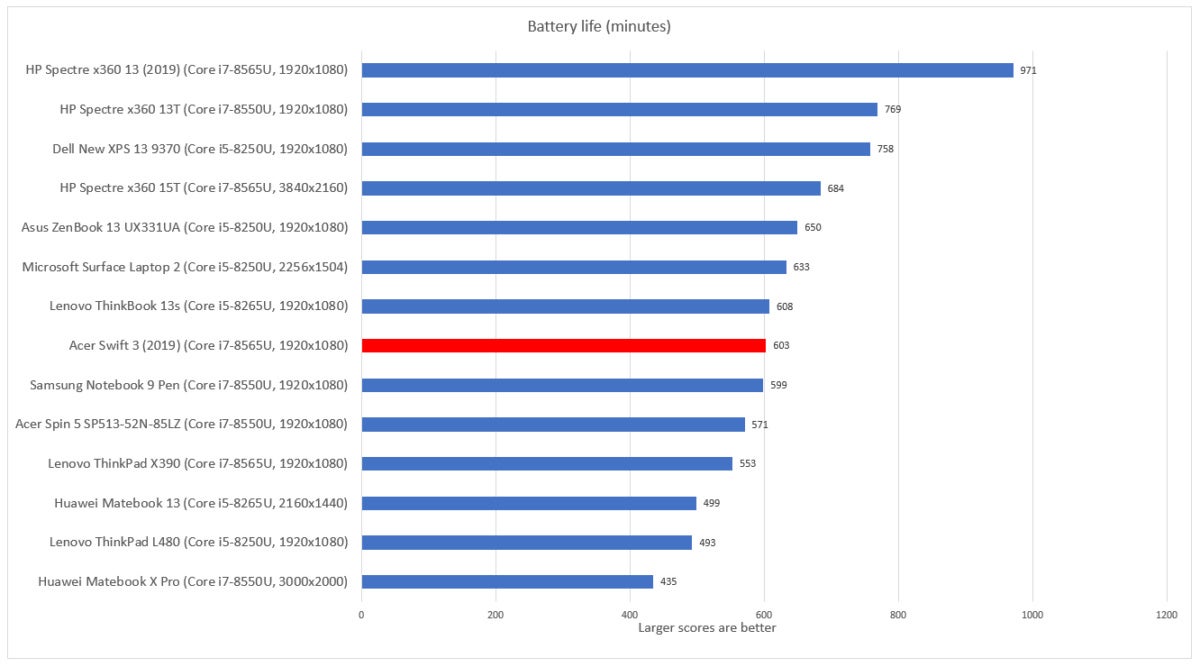 Mark Hachman / IDG
Mark Hachman / IDG
Not great battery life, comparatively speaking. But overall, about ten hours of battery life should be sufficient.
Conclusion: A solid option with some tradeoffs
Acer's Swift 3 is one of many notebooks we've tested to offer a Core i5 or Core i7, but its real differentiator is the downclocked MX150, which can't compare to the faster-clocked GeForce MX150 chips inside some of its competition. You won’t notice any dropoff in day-to-day use, however, and stepping up to a meatier discrete GPU for gaming can cost several hundred dollars more. (Alternatively, you can look at discounted notebooks that feature older 8th-generation chips, too, but those are still over $1,000.)
Buying a midrange to moderately cheap notebook does engender some tradeoffs and sacrifices. There are areas like USB-C connectivity and where we think the Swift 3 could improve. But the Swift 3’s performance is also excellent relative to its competition, with a nice IPS display, and all for a competitive price. Unless the negatives outweigh the positives for you. there's some decent value under the Acer Swift 3’s hood.

















